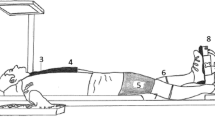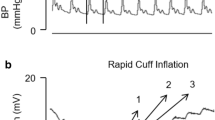Summary
Ten normal healthy subjects performed a rhythmic handgrip at 30016 MVC (maximal voluntary contraction) with and without arterial occlusion of the same limb. Contralateral forearm and calf venous capacitance were simultaneously measured by venous occlusion plethysmography. During rhythmic handgrip at 30% MVC contralateral venous capacitance decreased by -7.17% in the forearm and by -5.14% in the calf. With arterial occlusion the decreases in venous capacitance were even more pronounced: contralateral forearm-14.4% and calf -13.1%. In a second set of experiments (n = 5) rhythmic handgrip at 30% MVC with arrest of the forearm circulation 5 s prior to the cessation of contraction was applied to examine the influence of chemically sensitive metaboreceptors per se on the evoked limb venoconstriction. During the postexercise arterial occlusion forearm venous volume decreased further to -30.6% whereas calf venous volume increased slightly but remained below the control value. After the cessation of the arterial occlusion both forearm and calf capacitance returned to baseline values. Thus, this study provided evidence that as well as a chemically generated reflex arising from the working muscle, central command was found to be involved in the increase in venomotor tone in the nonexercising limbs during rhythmic handgrip at 30% MVC.
Similar content being viewed by others
References
Alam M, Smirk FH (1937) Observations in man upon a blood pressure raising reflex arising from the voluntary muscles. J Physiol (Lond) 89:372–383
Bevegård BS, Shepherd JT (1966) Reaction in man of resistance and capacity vessels in forearm and hand to leg exercise. J Appl Physiol 21:123–132
Christensen JJ, Calbo H (1983) Sympathetic nervous activity during exercise. Annu Rev Physiol 45:139–145
Cooper KE, Edholm OG, Mottram RF (1955) The blood flow in skin and muscle of the human forearm. J Physiol (Loud) 128:258–267
Duprez DA, Essandoh LK, Vanhoutte PM, Shepherd JT (1989) Vascular responses in forearm and calf to contralateral static exercise. J Appl Physiol 66:669–674
Eldridge FL, Millhorn DE, Killey JP, Waldrop TG (1985) Stimulation by central command of locomotion, respiration, and circulation during exercise. Respir Physiol 59:313–337
Essandoh LK, Duprez DA, Shepherd JT (1987) Postural cardiovascular reflexes: comparison of responses of forearm and calf resistance vessels. J Appl Physiol 63:1801–1805
Gascho JA, Fanelli C, Sumner A, Zelis R (1989) Effects of posture and the venodilatory response to nitroglycerin. J Appl Physiol 66:2585–2588
Kaufman MP, Rybicki KJ, Waldrop TG, Ordway GA (1984) Effect of ischemia on responses of group III and IV afferents to contraction. J Appl Physiol 57:644–650
Mark AL, Victor RG, Nerhed C, Wallin BG (1985) Microneurographic studies of the mechanisms of sympathetic nerve responses to static exercise in humans. Circ Res 57:461–469
McCloskey DI, Mitchell JH (1972) Reflex cardiovascular and respiratory responses originating in exercising muscle. J Physiol (Lond) 224:173–186
Mense S, Stahnke M (1983) Response in muscle afferent fibers of slow conduction velocity to contractions and ischemia in the cat. J Physiol 342:382–397
Mitchell JH, Schmidt RF (1983) Cardiovascular reflex control by afferent fibres from skeletal muscle receptors. In: Shepherd JT, Abboud FM (eds) Handbook of physiology, vol III, part 2. American Physiological Society, Bethesda, pp 623–658
Molhoek GP, Wesseling KJ, Settels JJ, Van Vollenhoven E, Weeda HWH, De Wit B, Arntzenius AC (1984) Evaluation of the Penaz Servo-plethysmo-manometer for the continuous non-invasive measurement of finger blood pressure. Basic Res Cardiol 79:498–609
Perez-Gonzalez JF (1981) Factors determining the blood pressure responses to isometric exercise. Circ Res 48:176–186
Rowell LB (1979) Human cardiovascular adjustments of exercise and thermal stress. Physiol Rev 54:75–159
Rowell LB (1986) How are cardiovascular and metabolic functions matched during exercise: what is the exercise stimulus? In: Rowell LB (ed) Human circulation regulation during physical stress. Oxford University Press, London, pp 287–322
Rowell LB, O'Leary DS (1990) Reflex control of the circulation during exercise: chemoreflexes and mechanoreflexes. J Appl Physiol 69:407–418
Rush NJ, Shepherd JT, Webb RC, Vanhoutte PH (1981) Different behaviour of the resistance vessels of the human calf and forearm during contralateral isometric exercise, mental stress and abnormal respiratory movements. Circ Res 48 [Suppl 1]:118–130
Saito M, Naito M, Mano T (1990) Different responses in skin and muscle sympathetic nerve activity to static muscle contraction. J Appl Physiol 69:2085–2090
Shepherd JT, Vanhoutte PM (1975) Veins and their control. Saunders, London, pp 135, 145-146
Shepherd JT, Blomgvist CG, Lind AE, Mitchell JH, Saltin B (1981) Static (isometric) exercise: retrospection and introspection. Circ Res 48 [Suppl 1]: 179–187
Simon E, Riedel W (1975) Diversity of regional sympathetic outflow in integrative cardiovascular control: patterns and mechanisms. Brain Res 87:323–333
Smith NT, Wesseling KH, De Wit B (1985) Evaluation of two prototype devices producing noninvasive, pulsatile, calibrated blood pressure measurement from a finger. J Clin Monit 1:17–29
Valbo AB, Hagbarth KE, Orebjörk HE, Wallin BG (1979) Somatosensory proprioreceptive and sympathetic activity in human peripheral nerves. Physiol Rev 59:919–957
Victor RG, Seals DR (1989) Reflex stimulation of sympathetic outflow during rhythmic exercise in humans. Am J Physiol 257: H2017-H2029
Victor RG, Seals DR, Mark AL (1987) Differential control of heart rate and sympathetic nerve activity in humans. J Clin Invest 79:508–516
Victor RG, Pryor SL, Secher NH, Mitchell JH (1989) Effects of partial neuromuscular blockade on sympathetic nerve responses to static exercise in humans. Circ Res 65:468–476
Whitney RJ (1953) The measurements of volume changes in human limbs. J Physiol 121:1–27
Wood JE, Eckstein JW (1958) A tandem forearm plethysmograph for study of acute responses of the peripheral veins of man: the effect of environmental and local temperature changes, and the effect of pooling blood in the extremities. J Clin Invest 37:41–50
Author information
Authors and Affiliations
Rights and permissions
About this article
Cite this article
Duprez, D.A., De Buyzere, M., De Sutter, J.M. et al. Venous responses to rhythmic exercise in contralateral forearm and calf. Europ. J. Appl. Physiol. 65, 94–98 (1992). https://doi.org/10.1007/BF01466281
Accepted:
Issue Date:
DOI: https://doi.org/10.1007/BF01466281




